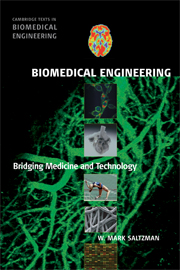Book contents
- Frontmatter
- Contents
- Preface
- Acknowledgments
- Abbreviations and Acronyms
- 1 Introduction: What Is Biomedical Engineering?
- PART 1 MOLECULAR AND CELLULAR PRINCIPLES
- 2 Biomolecular Principles
- 3 Biomolecular Principles: Nucleic Acids
- 4 Biomolecular Principles: Proteins
- 5 Cellular Principles
- PART 2 PHYSIOLOGICAL PRINCIPLES
- PART 3 BIOMEDICAL ENGINEERING
- Appendix A Physiological Parameters
- Appendix B Chemical Parameters
- Appendix C Units and Conversion Factors
- Index
- Plate section
- References
2 - Biomolecular Principles
from PART 1 - MOLECULAR AND CELLULAR PRINCIPLES
- Frontmatter
- Contents
- Preface
- Acknowledgments
- Abbreviations and Acronyms
- 1 Introduction: What Is Biomedical Engineering?
- PART 1 MOLECULAR AND CELLULAR PRINCIPLES
- 2 Biomolecular Principles
- 3 Biomolecular Principles: Nucleic Acids
- 4 Biomolecular Principles: Proteins
- 5 Cellular Principles
- PART 2 PHYSIOLOGICAL PRINCIPLES
- PART 3 BIOMEDICAL ENGINEERING
- Appendix A Physiological Parameters
- Appendix B Chemical Parameters
- Appendix C Units and Conversion Factors
- Index
- Plate section
- References
Summary
LEARNING OBJECTIVES
After reading this chapter, you should:
Understand the types of chemical bonds that hold atoms together in molecules.
Understand the difference between polar and nonpolar molecules, and the important role that polarity plays in interactions of biological molecules.
Understand the basic concepts of biochemical energetics, including the role of adenosine-5′-triphosphate (ATP) in the transformation of energy into biochemical work.
Understand the concepts of acids, bases, pH, and buffering.
Know the major classes of biological polymers: proteins, polysaccharides, and nucleic acids.
Understand the chemical structure of polysaccharides as polymers of monosaccharides, including the simple sugars glucose, galactose, and fructose.
Understand the basic structure of nucleic acids as polymers of nucleotides and how that structure is different in deoxyribonucleic acid (DNA) and ribonucleic acid (RNA) polymers.
Understand the basic structure of proteins, which are polymers of amino acids, and how the diversity of amino acid structure influences protein three-dimensional structure and function.
Understand how the chemical structure of phospholipids contributes to the properties of biological membranes.
Understand the basic features of biological membranes, which are lipid bilayers that are decorated with proteins and carbohydrates.
Understand the mechanisms of diffusion and osmotic pressure generation.
Prelude
Biomedical engineers are engaged in a great diversity of activities: Chapter 1 described many of the fields in which biomedical engineers make significant contributions. This chapter, together with Chapters 3 and 4, reviews fundamental chemistry concepts that are important for understanding human physiology and biomedical engineering (BME).
- Type
- Chapter
- Information
- Biomedical EngineeringBridging Medicine and Technology, pp. 31 - 81Publisher: Cambridge University PressPrint publication year: 2009



